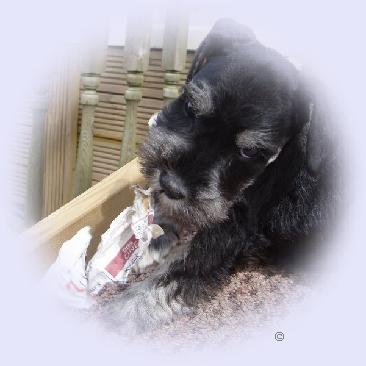
Basic Puppy Proofing

Puppies are inquisitive, which means, prior to bringing them home, it’s important to do a clean sweep of everything at puppy level. Sounds daft but the best way really is, to get on your hands and knees - puppy level - and crawl around the house. You never know what you will find, like that long lost earring or a fortune in lose change. Pick up every small item. "Swallowed coins, pins, needles, rubber bands, paper clips, staples, nails, screws, yarn, thread, dental floss, earrings… small balls left lying around can lodge in your puppy's digestive tract". Electrical cords are favourites of puppy snacks. While it may not be attractive, tape cords to the wall, then spray the tape with bitter apple or some other bad tasting dog chewing deterrent. This should not be forever, just a few months until the puppy learns what is his and what is off limits. The basic rule of thumb is this: if you need, love or value an item, take it out of puppy reach. . And remember, as puppies grow, so does their reach. So what may have been safe on the counter at 10 weeks becomes fair game when the puppy is four months old.
Once the floor is clear of all stray objects, scatter dog toys all over it and praise the puppy when he chews on them, versus something of yours. If the puppy does happen to get something of yours, trade it for one of their toys and praise them for giving it up. This brings about another general rule: if it's on the floor, it belongs to the dog. Keep this in mind when guests come over and leave their shoes by the front door. They may very well go home with one shoe.
Puppies should never be left to their own devices inside or outside. If you cannot be in the same room as your puppy, then they should be in their crate or some other enclosed safe area. Crates are designed to be happy, safe and secure places for a puppy. (Not a place of punishment or banishment) and should have a bed or blanket for them to lie on as well as a few favourite toys. It is as much a place for you to put him when you can't watch them, as it is a place for puppy to go and be by there own. Always leave the crate door open - unless you are containing them so they can go into and out of it whenever they want to take a nap. This helps ensure they view the crate as a safe and pleasurable spot.
Not only are there puppy hazards indoors, but also outdoors. Before planting your flower and vegetable gardens, consider which plants and fertilizers are toxic to dogs.
Potentially toxic plants include Philodendrons, Azaleas and Honeysuckles. Other hazardous plants include Cactus, Dumb cane, Mistletoe, Poinsettia, Cherry Seeds, Daffodil blooms, Horse Chestnuts, Holly, Lily of the Valley, Morning Glory, Rhubarb, Skunk Cabbage, Tulip bulbs and wild mushrooms, Other things to avoid in the garden are slug/snail killing pellets and cocoa mulch. Cocoa mulch is made from cocoa beans, which contain Theo bromine - the ingredient in chocolate, which is toxic to dogs.
A sure sign of summer is a dog peacefully sleeping on the porch, soaking up the sun. However, if they are lying on unsealed pressure treated wood, dogs are also soaking up some unfriendly chemicals. The very chemicals used to treat pressure treated wood, can be toxic to dogs, which is why it is important to seal the wood. The pressure treating chemicals can leak into the soil, therefore, pets should never be allowed under the deck to sleep or play.
Keep dogs off chemically treated/fertilized lawns for 24 hours. It may be best to not allow them on anyone's lawn, unless you know whether or not they use lawn chemicals. Keep sheds and garage doors closed. "It's easy for dogs to nose their way into [open garages and sheds] and for their paws to become contaminated with garden chemicals,"
Potentially toxic plants include Philodendrons, Azaleas and Honeysuckles. Other hazardous plants include Cactus, Dumb cane, Mistletoe, Poinsettia, Cherry Seeds, Daffodil blooms, Horse Chestnuts, Holly, Lily of the Valley, Morning Glory, Rhubarb, Skunk Cabbage, Tulip bulbs and wild mushrooms, Other things to avoid in the garden are slug/snail killing pellets and cocoa mulch. Cocoa mulch is made from cocoa beans, which contain Theo bromine - the ingredient in chocolate, which is toxic to dogs.
A sure sign of summer is a dog peacefully sleeping on the porch, soaking up the sun. However, if they are lying on unsealed pressure treated wood, dogs are also soaking up some unfriendly chemicals. The very chemicals used to treat pressure treated wood, can be toxic to dogs, which is why it is important to seal the wood. The pressure treating chemicals can leak into the soil, therefore, pets should never be allowed under the deck to sleep or play.
Keep dogs off chemically treated/fertilized lawns for 24 hours. It may be best to not allow them on anyone's lawn, unless you know whether or not they use lawn chemicals. Keep sheds and garage doors closed. "It's easy for dogs to nose their way into [open garages and sheds] and for their paws to become contaminated with garden chemicals,"